Introduction to Clinical Epidemiology Assignment: Analysis of Studies
VerifiedAdded on 2023/06/10
|12
|2139
|231
Homework Assignment
AI Summary
This clinical epidemiology assignment presents a comprehensive analysis of research studies, focusing on key concepts such as sensitivity, specificity, and predictive values. The assignment includes a 2x2 table analysis to calculate these metrics, along with interpretations of the results. Furthermore, the assignment explores the validity, clinical significance, and generalizability of research findings, using examples from a provided study abstract. The student is required to critically evaluate study characteristics, determine statistical and clinical significance, and assess the relevance of findings to a broader context. Questions cover risk calculations, relative risk assessment, and the interpretation of statistical measures. The assignment also delves into the importance of internal validity, and the impact of sample bias.
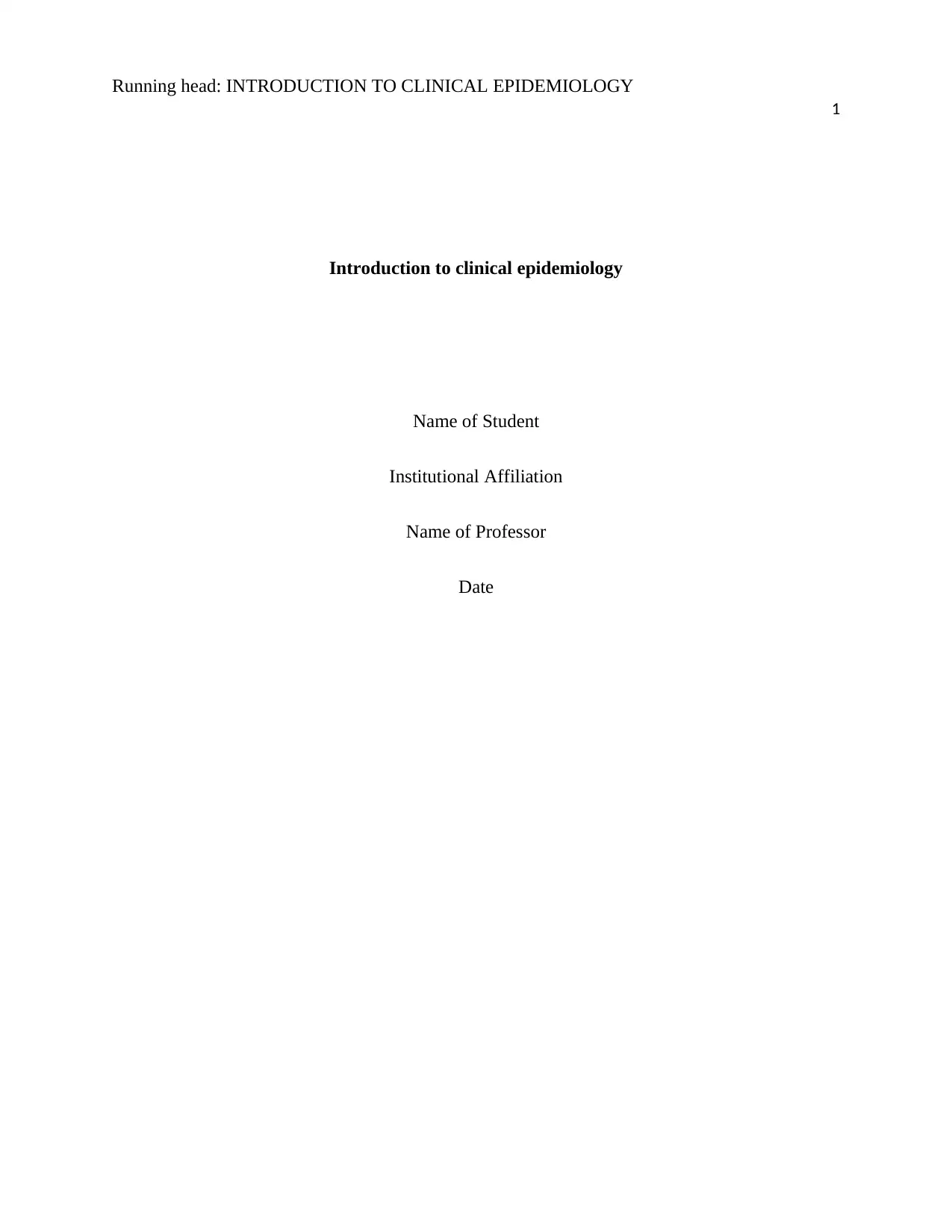
Running head: INTRODUCTION TO CLINICAL EPIDEMIOLOGY
1
Introduction to clinical epidemiology
Name of Student
Institutional Affiliation
Name of Professor
Date
1
Introduction to clinical epidemiology
Name of Student
Institutional Affiliation
Name of Professor
Date
Paraphrase This Document
Need a fresh take? Get an instant paraphrase of this document with our AI Paraphraser
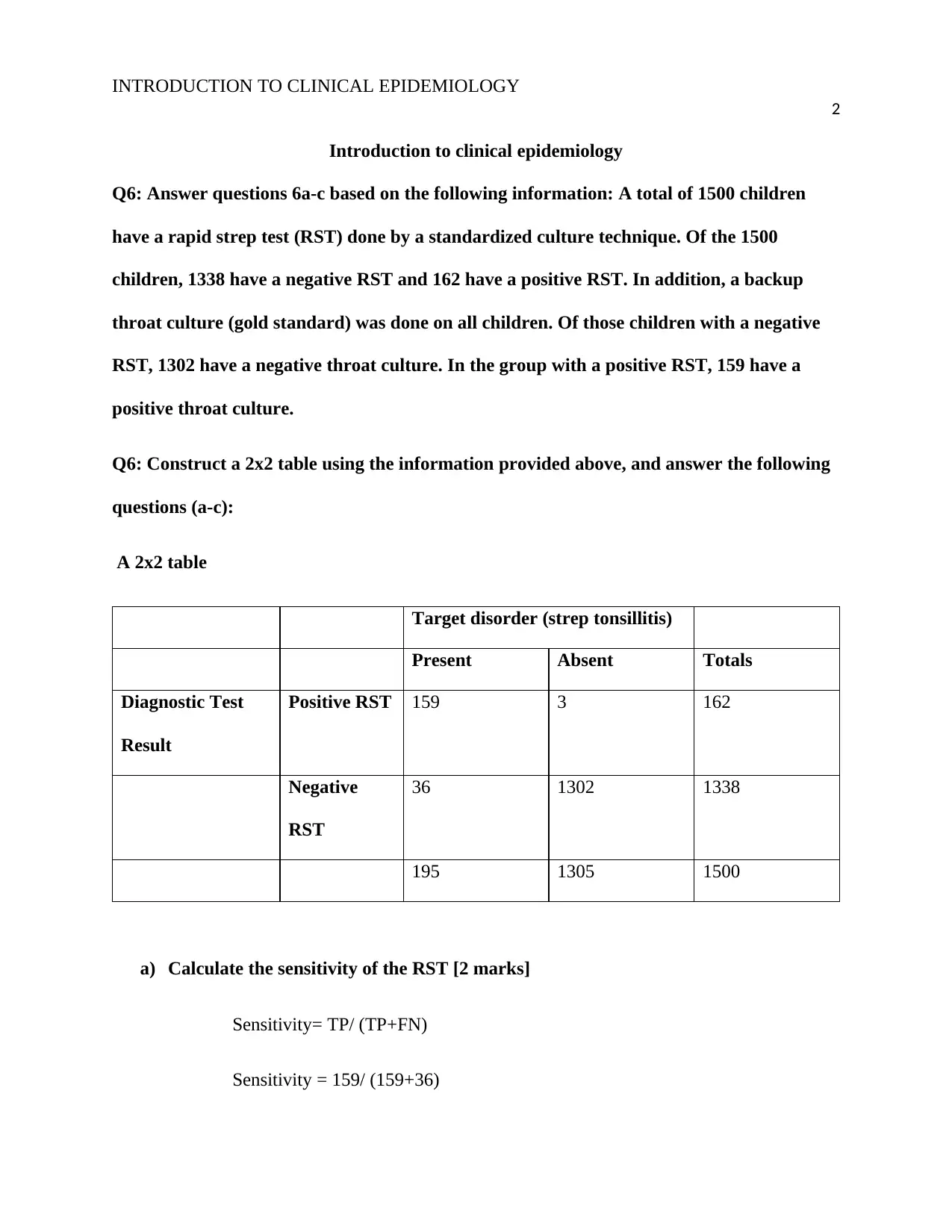
INTRODUCTION TO CLINICAL EPIDEMIOLOGY
2
Introduction to clinical epidemiology
Q6: Answer questions 6a-c based on the following information: A total of 1500 children
have a rapid strep test (RST) done by a standardized culture technique. Of the 1500
children, 1338 have a negative RST and 162 have a positive RST. In addition, a backup
throat culture (gold standard) was done on all children. Of those children with a negative
RST, 1302 have a negative throat culture. In the group with a positive RST, 159 have a
positive throat culture.
Q6: Construct a 2x2 table using the information provided above, and answer the following
questions (a-c):
A 2x2 table
Target disorder (strep tonsillitis)
Present Absent Totals
Diagnostic Test
Result
Positive RST 159 3 162
Negative
RST
36 1302 1338
195 1305 1500
a) Calculate the sensitivity of the RST [2 marks]
Sensitivity= TP/ (TP+FN)
Sensitivity = 159/ (159+36)
2
Introduction to clinical epidemiology
Q6: Answer questions 6a-c based on the following information: A total of 1500 children
have a rapid strep test (RST) done by a standardized culture technique. Of the 1500
children, 1338 have a negative RST and 162 have a positive RST. In addition, a backup
throat culture (gold standard) was done on all children. Of those children with a negative
RST, 1302 have a negative throat culture. In the group with a positive RST, 159 have a
positive throat culture.
Q6: Construct a 2x2 table using the information provided above, and answer the following
questions (a-c):
A 2x2 table
Target disorder (strep tonsillitis)
Present Absent Totals
Diagnostic Test
Result
Positive RST 159 3 162
Negative
RST
36 1302 1338
195 1305 1500
a) Calculate the sensitivity of the RST [2 marks]
Sensitivity= TP/ (TP+FN)
Sensitivity = 159/ (159+36)

INTRODUCTION TO CLINICAL EPIDEMIOLOGY
3
Sensitivity = 159/195
= 0.815
=81.5%
b) Calculate the specificity of the RST [2 marks]
Specificity = TN/ (FP+TN)
Specificity = 1302/ (3+1302)
Specificity = 1302/ 1305
= 0.997
= 99.7%
c) Calculate the positive predictive value of the RST [2 marks]
The positive predictive value is given by the probability of the disease among
patients with a positive test.
PPV= TP/ (TP+FP)
=159/ (159+3)
=159/162
=0.9815
= 98.15%
3
Sensitivity = 159/195
= 0.815
=81.5%
b) Calculate the specificity of the RST [2 marks]
Specificity = TN/ (FP+TN)
Specificity = 1302/ (3+1302)
Specificity = 1302/ 1305
= 0.997
= 99.7%
c) Calculate the positive predictive value of the RST [2 marks]
The positive predictive value is given by the probability of the disease among
patients with a positive test.
PPV= TP/ (TP+FP)
=159/ (159+3)
=159/162
=0.9815
= 98.15%
⊘ This is a preview!⊘
Do you want full access?
Subscribe today to unlock all pages.

Trusted by 1+ million students worldwide
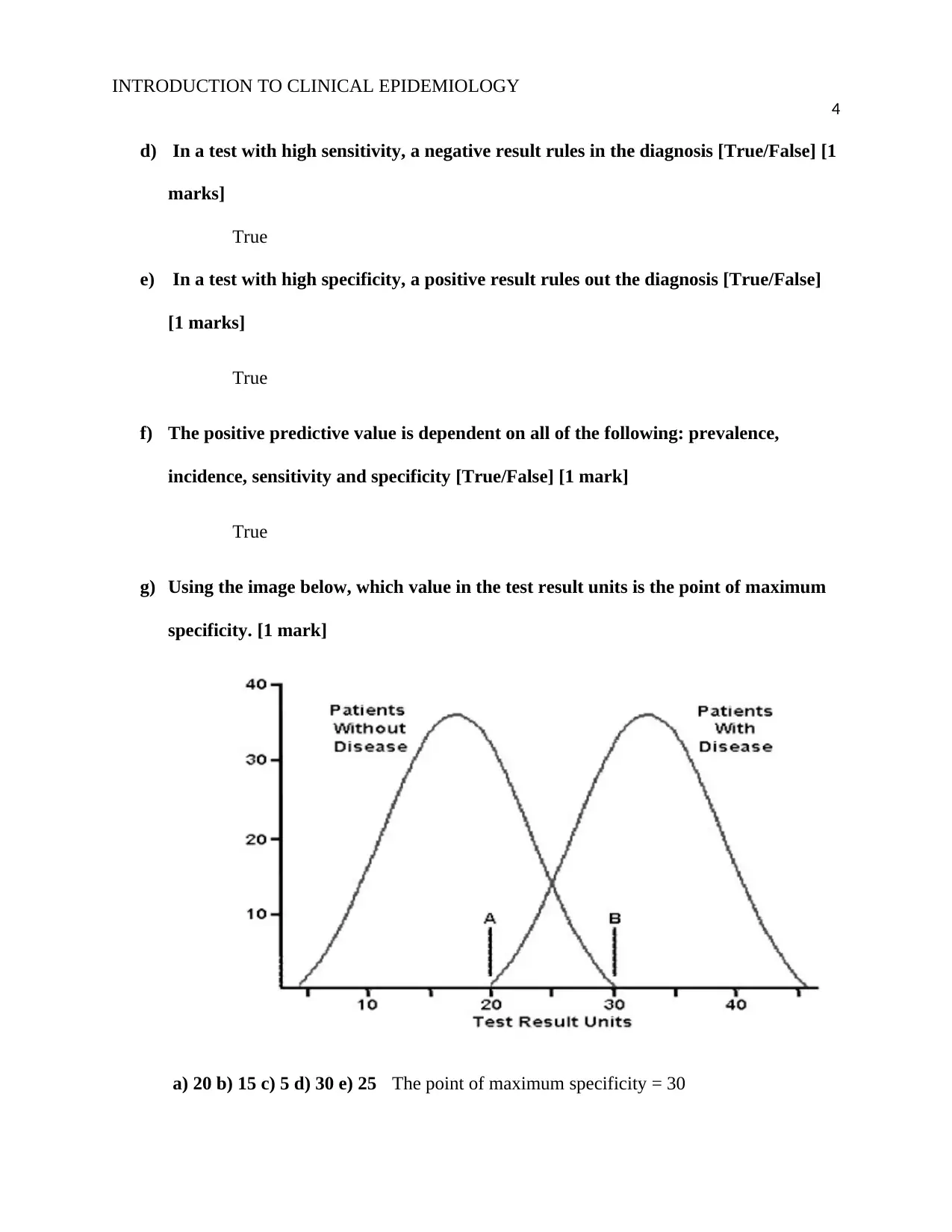
INTRODUCTION TO CLINICAL EPIDEMIOLOGY
4
d) In a test with high sensitivity, a negative result rules in the diagnosis [True/False] [1
marks]
True
e) In a test with high specificity, a positive result rules out the diagnosis [True/False]
[1 marks]
True
f) The positive predictive value is dependent on all of the following: prevalence,
incidence, sensitivity and specificity [True/False] [1 mark]
True
g) Using the image below, which value in the test result units is the point of maximum
specificity. [1 mark]
a) 20 b) 15 c) 5 d) 30 e) 25 The point of maximum specificity = 30
4
d) In a test with high sensitivity, a negative result rules in the diagnosis [True/False] [1
marks]
True
e) In a test with high specificity, a positive result rules out the diagnosis [True/False]
[1 marks]
True
f) The positive predictive value is dependent on all of the following: prevalence,
incidence, sensitivity and specificity [True/False] [1 mark]
True
g) Using the image below, which value in the test result units is the point of maximum
specificity. [1 mark]
a) 20 b) 15 c) 5 d) 30 e) 25 The point of maximum specificity = 30
Paraphrase This Document
Need a fresh take? Get an instant paraphrase of this document with our AI Paraphraser
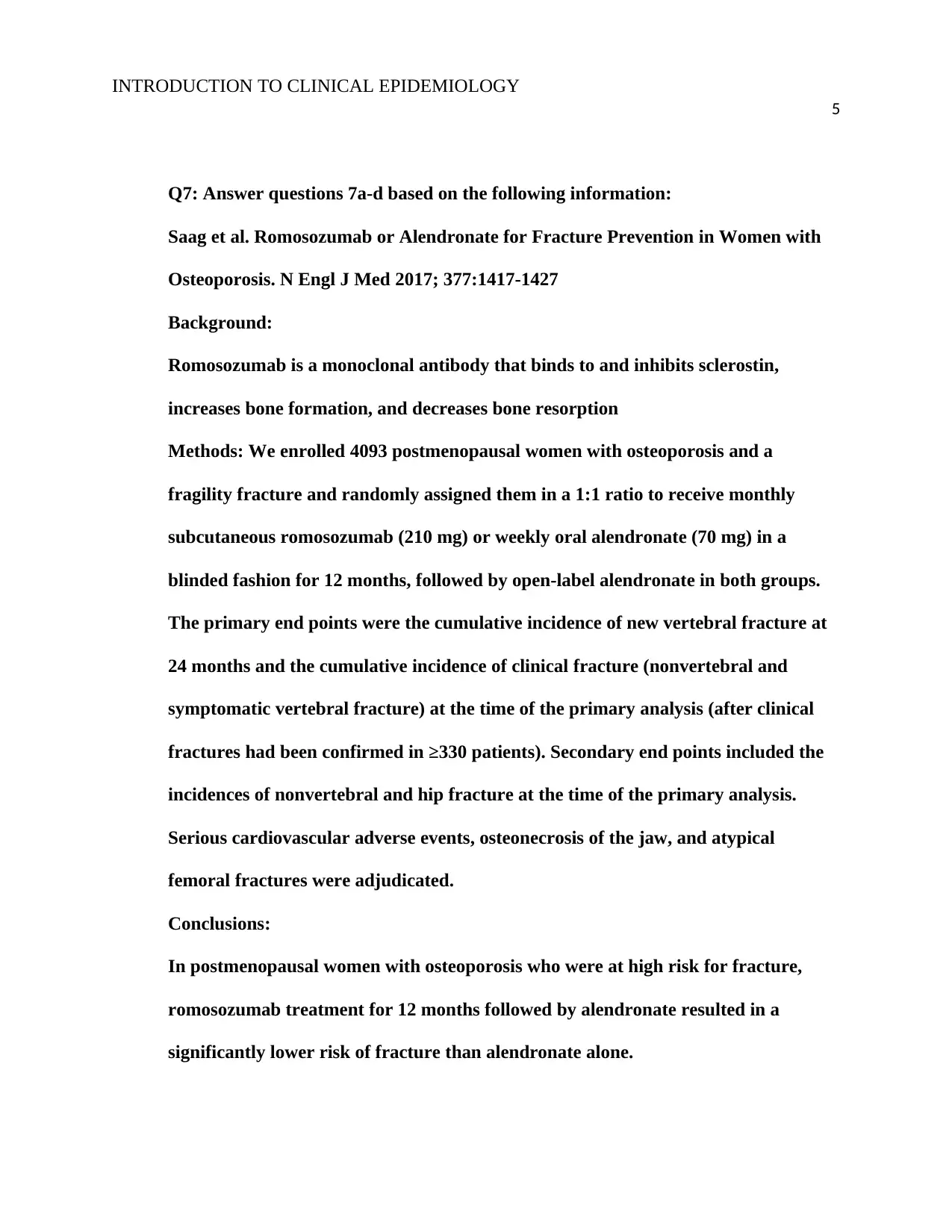
INTRODUCTION TO CLINICAL EPIDEMIOLOGY
5
Q7: Answer questions 7a-d based on the following information:
Saag et al. Romosozumab or Alendronate for Fracture Prevention in Women with
Osteoporosis. N Engl J Med 2017; 377:1417-1427
Background:
Romosozumab is a monoclonal antibody that binds to and inhibits sclerostin,
increases bone formation, and decreases bone resorption
Methods: We enrolled 4093 postmenopausal women with osteoporosis and a
fragility fracture and randomly assigned them in a 1:1 ratio to receive monthly
subcutaneous romosozumab (210 mg) or weekly oral alendronate (70 mg) in a
blinded fashion for 12 months, followed by open-label alendronate in both groups.
The primary end points were the cumulative incidence of new vertebral fracture at
24 months and the cumulative incidence of clinical fracture (nonvertebral and
symptomatic vertebral fracture) at the time of the primary analysis (after clinical
fractures had been confirmed in ≥330 patients). Secondary end points included the
incidences of nonvertebral and hip fracture at the time of the primary analysis.
Serious cardiovascular adverse events, osteonecrosis of the jaw, and atypical
femoral fractures were adjudicated.
Conclusions:
In postmenopausal women with osteoporosis who were at high risk for fracture,
romosozumab treatment for 12 months followed by alendronate resulted in a
significantly lower risk of fracture than alendronate alone.
5
Q7: Answer questions 7a-d based on the following information:
Saag et al. Romosozumab or Alendronate for Fracture Prevention in Women with
Osteoporosis. N Engl J Med 2017; 377:1417-1427
Background:
Romosozumab is a monoclonal antibody that binds to and inhibits sclerostin,
increases bone formation, and decreases bone resorption
Methods: We enrolled 4093 postmenopausal women with osteoporosis and a
fragility fracture and randomly assigned them in a 1:1 ratio to receive monthly
subcutaneous romosozumab (210 mg) or weekly oral alendronate (70 mg) in a
blinded fashion for 12 months, followed by open-label alendronate in both groups.
The primary end points were the cumulative incidence of new vertebral fracture at
24 months and the cumulative incidence of clinical fracture (nonvertebral and
symptomatic vertebral fracture) at the time of the primary analysis (after clinical
fractures had been confirmed in ≥330 patients). Secondary end points included the
incidences of nonvertebral and hip fracture at the time of the primary analysis.
Serious cardiovascular adverse events, osteonecrosis of the jaw, and atypical
femoral fractures were adjudicated.
Conclusions:
In postmenopausal women with osteoporosis who were at high risk for fracture,
romosozumab treatment for 12 months followed by alendronate resulted in a
significantly lower risk of fracture than alendronate alone.
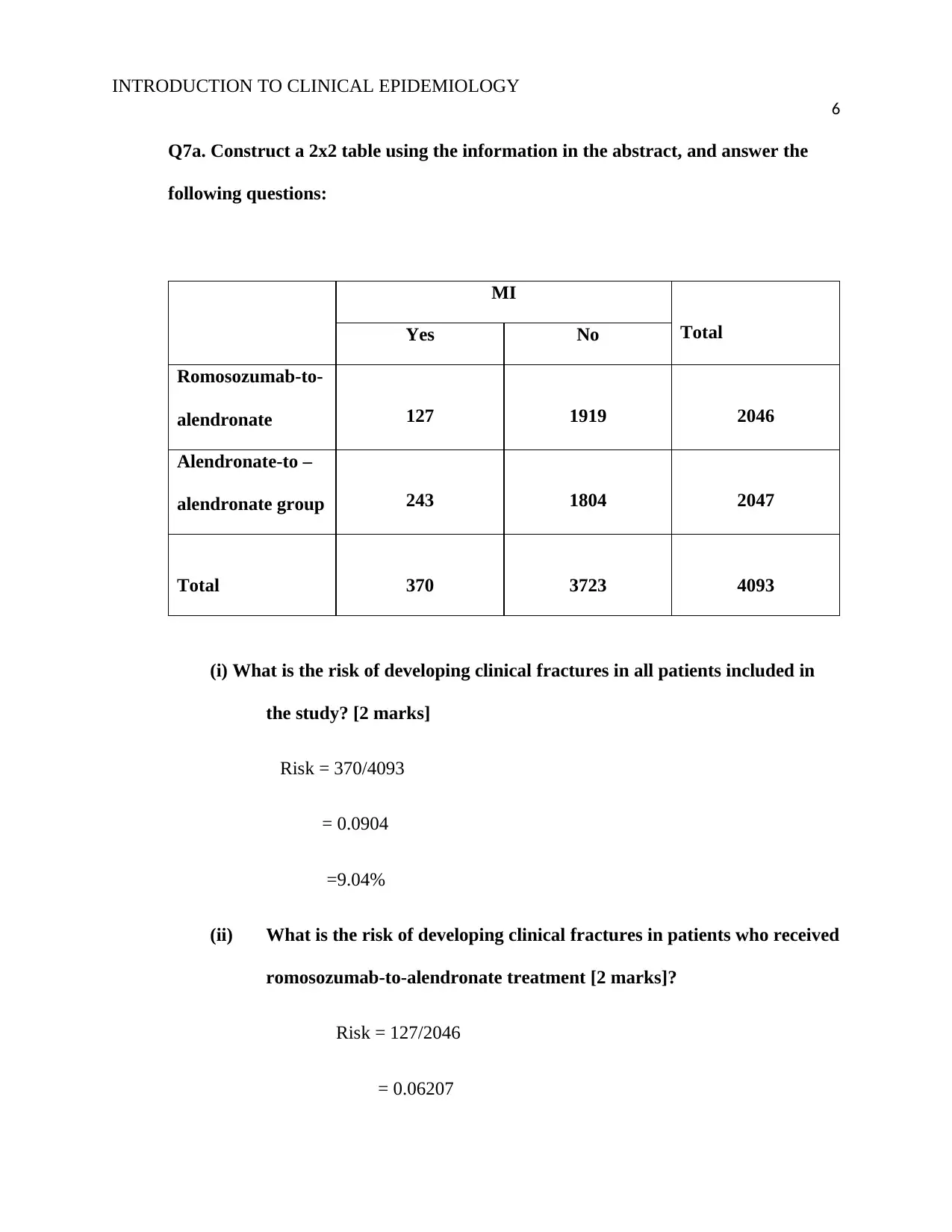
INTRODUCTION TO CLINICAL EPIDEMIOLOGY
6
Q7a. Construct a 2x2 table using the information in the abstract, and answer the
following questions:
MI
TotalYes No
Romosozumab-to-
alendronate 127 1919 2046
Alendronate-to –
alendronate group 243 1804 2047
Total 370 3723 4093
(i) What is the risk of developing clinical fractures in all patients included in
the study? [2 marks]
Risk = 370/4093
= 0.0904
=9.04%
(ii) What is the risk of developing clinical fractures in patients who received
romosozumab-to-alendronate treatment [2 marks]?
Risk = 127/2046
= 0.06207
6
Q7a. Construct a 2x2 table using the information in the abstract, and answer the
following questions:
MI
TotalYes No
Romosozumab-to-
alendronate 127 1919 2046
Alendronate-to –
alendronate group 243 1804 2047
Total 370 3723 4093
(i) What is the risk of developing clinical fractures in all patients included in
the study? [2 marks]
Risk = 370/4093
= 0.0904
=9.04%
(ii) What is the risk of developing clinical fractures in patients who received
romosozumab-to-alendronate treatment [2 marks]?
Risk = 127/2046
= 0.06207
⊘ This is a preview!⊘
Do you want full access?
Subscribe today to unlock all pages.

Trusted by 1+ million students worldwide

INTRODUCTION TO CLINICAL EPIDEMIOLOGY
7
= 6.2%
(iii) What is the risk of developing clinical fractures in patients who
received alendronate-to-alendronate treatment? [2 marks]
Risk = Risk = 243/2047
= 0.1187
= 11.9%
(iv) What is the relative risk of treatment with romosozumab-to-
alendronate versus alendronateto-alendronate with regard to
experiencing clinical fractures? How would you interpret this relative
risk estimate? [4 marks]
Relative risk = 6.2/11.9
= 0.521
= 1:2
This implies that for one single risk of treatment with romosozumab-to-
alendronate, there will be two cases of risks of treatment with alendronateto-
alendronate.
Q7b. If equal numbers of patients in the population received romosozumab-to-alendronate
vs alendronate-to-alendronate treatment, what would be the expected population relative
risk reduction (RRR) for romosozumab-to-alendronate treatment? How would you
interpret this measure? [4 marks]
7
= 6.2%
(iii) What is the risk of developing clinical fractures in patients who
received alendronate-to-alendronate treatment? [2 marks]
Risk = Risk = 243/2047
= 0.1187
= 11.9%
(iv) What is the relative risk of treatment with romosozumab-to-
alendronate versus alendronateto-alendronate with regard to
experiencing clinical fractures? How would you interpret this relative
risk estimate? [4 marks]
Relative risk = 6.2/11.9
= 0.521
= 1:2
This implies that for one single risk of treatment with romosozumab-to-
alendronate, there will be two cases of risks of treatment with alendronateto-
alendronate.
Q7b. If equal numbers of patients in the population received romosozumab-to-alendronate
vs alendronate-to-alendronate treatment, what would be the expected population relative
risk reduction (RRR) for romosozumab-to-alendronate treatment? How would you
interpret this measure? [4 marks]
Paraphrase This Document
Need a fresh take? Get an instant paraphrase of this document with our AI Paraphraser
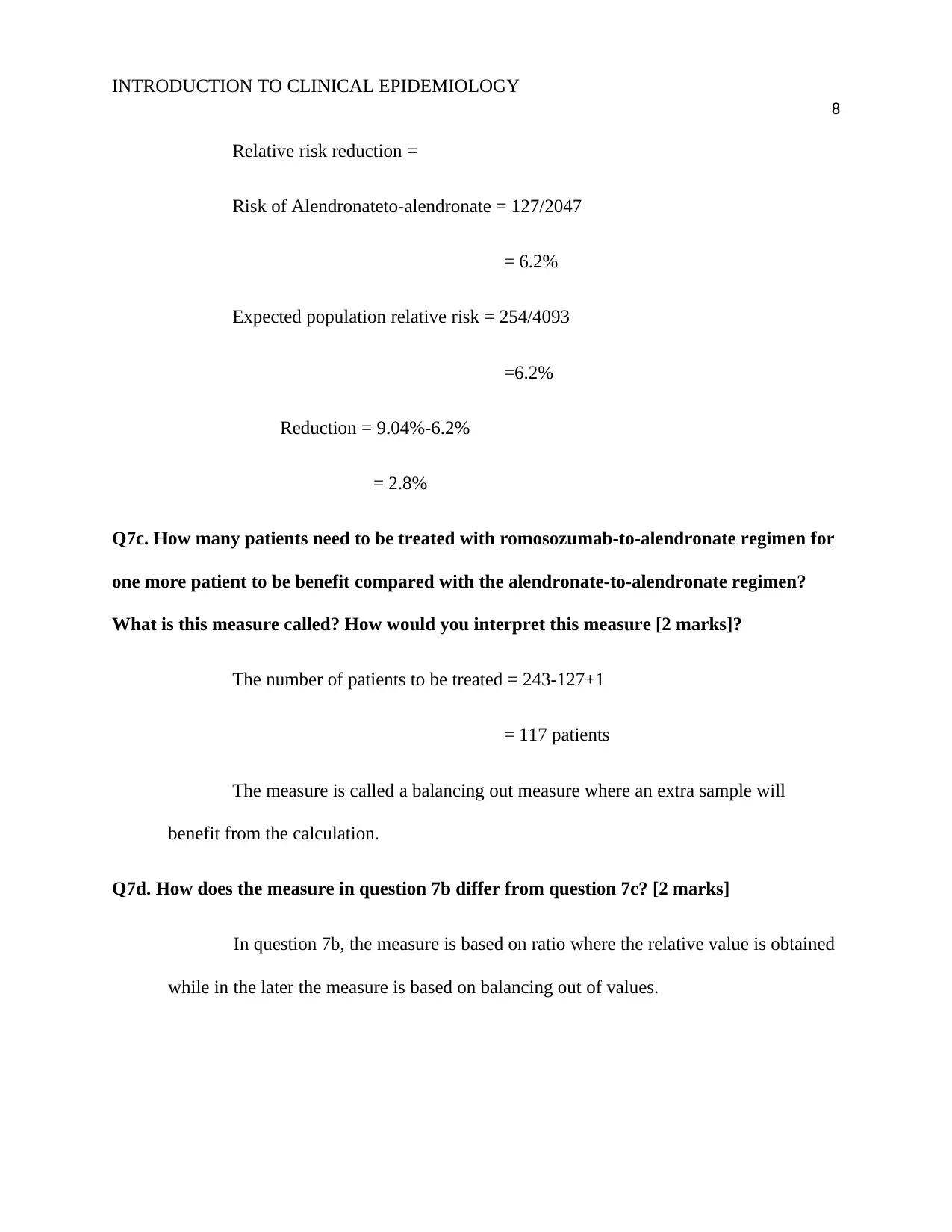
INTRODUCTION TO CLINICAL EPIDEMIOLOGY
8
Relative risk reduction =
Risk of Alendronateto-alendronate = 127/2047
= 6.2%
Expected population relative risk = 254/4093
=6.2%
Reduction = 9.04%-6.2%
= 2.8%
Q7c. How many patients need to be treated with romosozumab-to-alendronate regimen for
one more patient to be benefit compared with the alendronate-to-alendronate regimen?
What is this measure called? How would you interpret this measure [2 marks]?
The number of patients to be treated = 243-127+1
= 117 patients
The measure is called a balancing out measure where an extra sample will
benefit from the calculation.
Q7d. How does the measure in question 7b differ from question 7c? [2 marks]
In question 7b, the measure is based on ratio where the relative value is obtained
while in the later the measure is based on balancing out of values.
8
Relative risk reduction =
Risk of Alendronateto-alendronate = 127/2047
= 6.2%
Expected population relative risk = 254/4093
=6.2%
Reduction = 9.04%-6.2%
= 2.8%
Q7c. How many patients need to be treated with romosozumab-to-alendronate regimen for
one more patient to be benefit compared with the alendronate-to-alendronate regimen?
What is this measure called? How would you interpret this measure [2 marks]?
The number of patients to be treated = 243-127+1
= 117 patients
The measure is called a balancing out measure where an extra sample will
benefit from the calculation.
Q7d. How does the measure in question 7b differ from question 7c? [2 marks]
In question 7b, the measure is based on ratio where the relative value is obtained
while in the later the measure is based on balancing out of values.
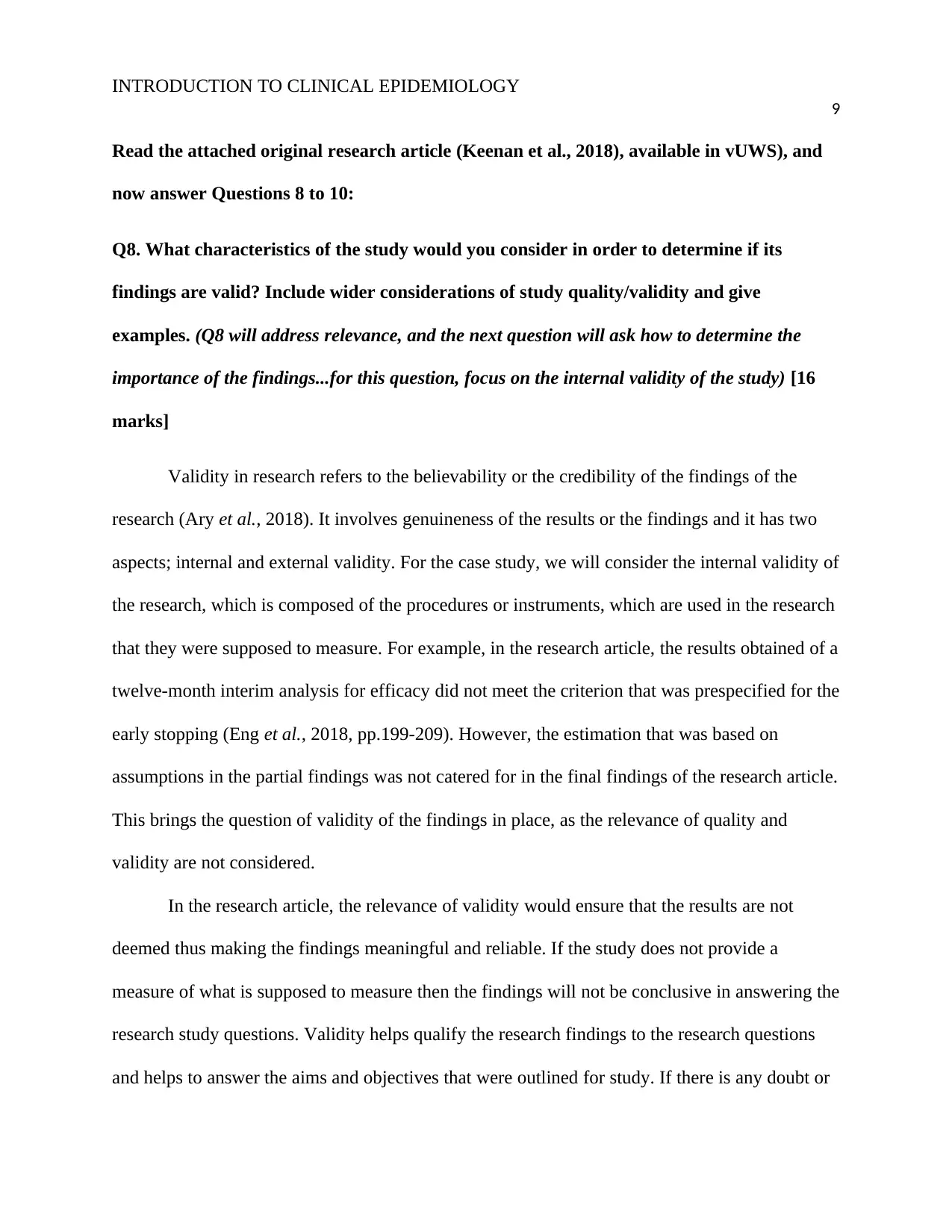
INTRODUCTION TO CLINICAL EPIDEMIOLOGY
9
Read the attached original research article (Keenan et al., 2018), available in vUWS), and
now answer Questions 8 to 10:
Q8. What characteristics of the study would you consider in order to determine if its
findings are valid? Include wider considerations of study quality/validity and give
examples. (Q8 will address relevance, and the next question will ask how to determine the
importance of the findings...for this question, focus on the internal validity of the study) [16
marks]
Validity in research refers to the believability or the credibility of the findings of the
research (Ary et al., 2018). It involves genuineness of the results or the findings and it has two
aspects; internal and external validity. For the case study, we will consider the internal validity of
the research, which is composed of the procedures or instruments, which are used in the research
that they were supposed to measure. For example, in the research article, the results obtained of a
twelve-month interim analysis for efficacy did not meet the criterion that was prespecified for the
early stopping (Eng et al., 2018, pp.199-209). However, the estimation that was based on
assumptions in the partial findings was not catered for in the final findings of the research article.
This brings the question of validity of the findings in place, as the relevance of quality and
validity are not considered.
In the research article, the relevance of validity would ensure that the results are not
deemed thus making the findings meaningful and reliable. If the study does not provide a
measure of what is supposed to measure then the findings will not be conclusive in answering the
research study questions. Validity helps qualify the research findings to the research questions
and helps to answer the aims and objectives that were outlined for study. If there is any doubt or
9
Read the attached original research article (Keenan et al., 2018), available in vUWS), and
now answer Questions 8 to 10:
Q8. What characteristics of the study would you consider in order to determine if its
findings are valid? Include wider considerations of study quality/validity and give
examples. (Q8 will address relevance, and the next question will ask how to determine the
importance of the findings...for this question, focus on the internal validity of the study) [16
marks]
Validity in research refers to the believability or the credibility of the findings of the
research (Ary et al., 2018). It involves genuineness of the results or the findings and it has two
aspects; internal and external validity. For the case study, we will consider the internal validity of
the research, which is composed of the procedures or instruments, which are used in the research
that they were supposed to measure. For example, in the research article, the results obtained of a
twelve-month interim analysis for efficacy did not meet the criterion that was prespecified for the
early stopping (Eng et al., 2018, pp.199-209). However, the estimation that was based on
assumptions in the partial findings was not catered for in the final findings of the research article.
This brings the question of validity of the findings in place, as the relevance of quality and
validity are not considered.
In the research article, the relevance of validity would ensure that the results are not
deemed thus making the findings meaningful and reliable. If the study does not provide a
measure of what is supposed to measure then the findings will not be conclusive in answering the
research study questions. Validity helps qualify the research findings to the research questions
and helps to answer the aims and objectives that were outlined for study. If there is any doubt or
⊘ This is a preview!⊘
Do you want full access?
Subscribe today to unlock all pages.

Trusted by 1+ million students worldwide
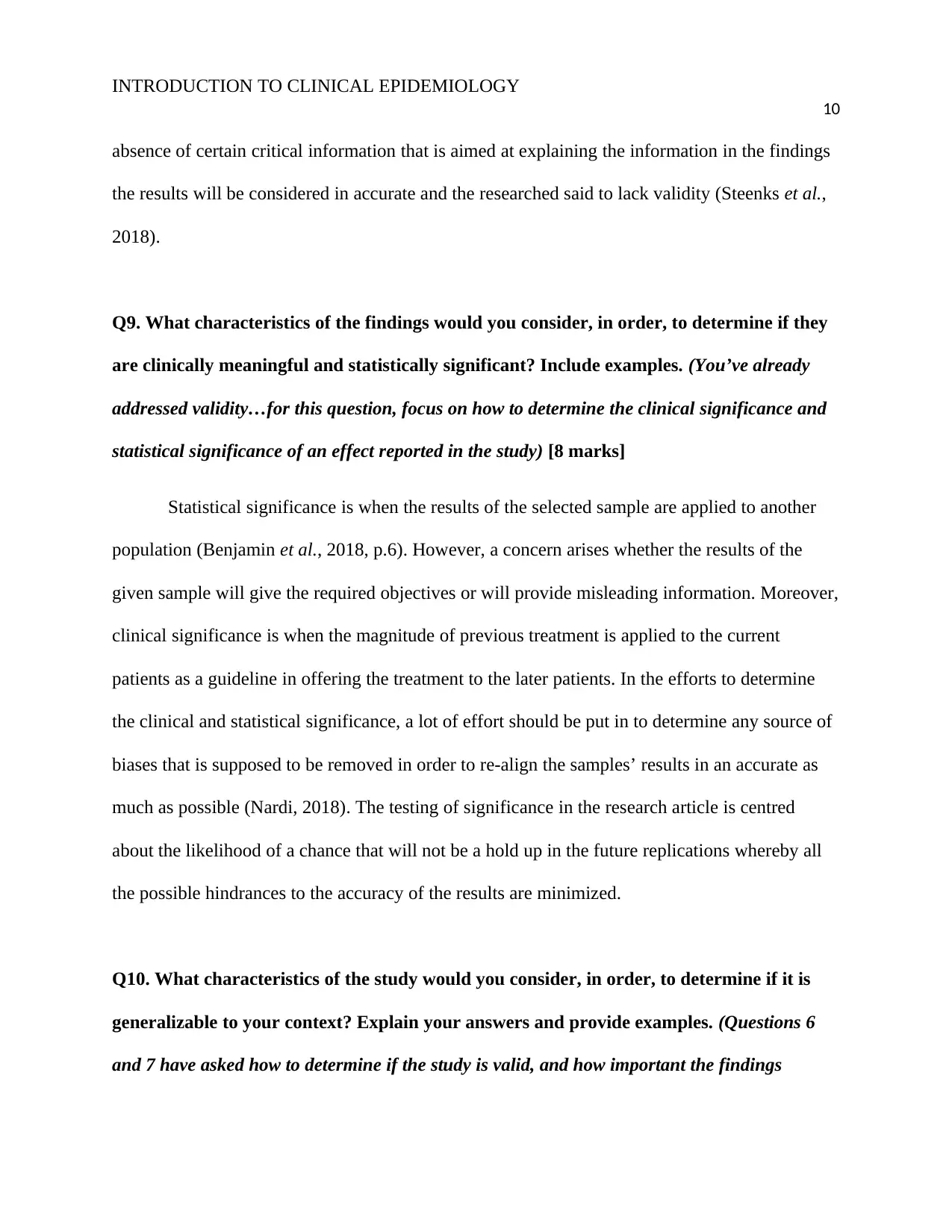
INTRODUCTION TO CLINICAL EPIDEMIOLOGY
10
absence of certain critical information that is aimed at explaining the information in the findings
the results will be considered in accurate and the researched said to lack validity (Steenks et al.,
2018).
Q9. What characteristics of the findings would you consider, in order, to determine if they
are clinically meaningful and statistically significant? Include examples. (You’ve already
addressed validity…for this question, focus on how to determine the clinical significance and
statistical significance of an effect reported in the study) [8 marks]
Statistical significance is when the results of the selected sample are applied to another
population (Benjamin et al., 2018, p.6). However, a concern arises whether the results of the
given sample will give the required objectives or will provide misleading information. Moreover,
clinical significance is when the magnitude of previous treatment is applied to the current
patients as a guideline in offering the treatment to the later patients. In the efforts to determine
the clinical and statistical significance, a lot of effort should be put in to determine any source of
biases that is supposed to be removed in order to re-align the samples’ results in an accurate as
much as possible (Nardi, 2018). The testing of significance in the research article is centred
about the likelihood of a chance that will not be a hold up in the future replications whereby all
the possible hindrances to the accuracy of the results are minimized.
Q10. What characteristics of the study would you consider, in order, to determine if it is
generalizable to your context? Explain your answers and provide examples. (Questions 6
and 7 have asked how to determine if the study is valid, and how important the findings
10
absence of certain critical information that is aimed at explaining the information in the findings
the results will be considered in accurate and the researched said to lack validity (Steenks et al.,
2018).
Q9. What characteristics of the findings would you consider, in order, to determine if they
are clinically meaningful and statistically significant? Include examples. (You’ve already
addressed validity…for this question, focus on how to determine the clinical significance and
statistical significance of an effect reported in the study) [8 marks]
Statistical significance is when the results of the selected sample are applied to another
population (Benjamin et al., 2018, p.6). However, a concern arises whether the results of the
given sample will give the required objectives or will provide misleading information. Moreover,
clinical significance is when the magnitude of previous treatment is applied to the current
patients as a guideline in offering the treatment to the later patients. In the efforts to determine
the clinical and statistical significance, a lot of effort should be put in to determine any source of
biases that is supposed to be removed in order to re-align the samples’ results in an accurate as
much as possible (Nardi, 2018). The testing of significance in the research article is centred
about the likelihood of a chance that will not be a hold up in the future replications whereby all
the possible hindrances to the accuracy of the results are minimized.
Q10. What characteristics of the study would you consider, in order, to determine if it is
generalizable to your context? Explain your answers and provide examples. (Questions 6
and 7 have asked how to determine if the study is valid, and how important the findings
Paraphrase This Document
Need a fresh take? Get an instant paraphrase of this document with our AI Paraphraser
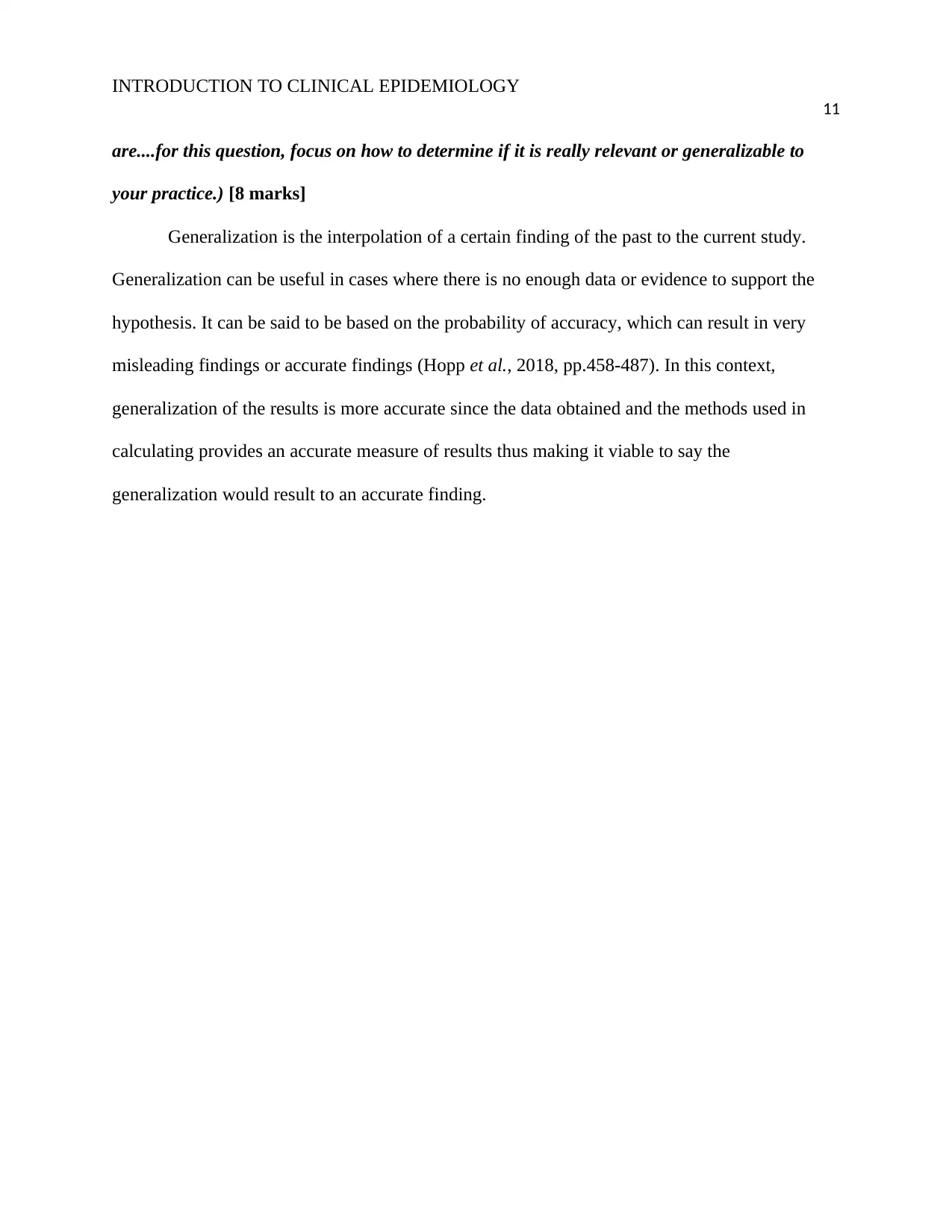
INTRODUCTION TO CLINICAL EPIDEMIOLOGY
11
are....for this question, focus on how to determine if it is really relevant or generalizable to
your practice.) [8 marks]
Generalization is the interpolation of a certain finding of the past to the current study.
Generalization can be useful in cases where there is no enough data or evidence to support the
hypothesis. It can be said to be based on the probability of accuracy, which can result in very
misleading findings or accurate findings (Hopp et al., 2018, pp.458-487). In this context,
generalization of the results is more accurate since the data obtained and the methods used in
calculating provides an accurate measure of results thus making it viable to say the
generalization would result to an accurate finding.
11
are....for this question, focus on how to determine if it is really relevant or generalizable to
your practice.) [8 marks]
Generalization is the interpolation of a certain finding of the past to the current study.
Generalization can be useful in cases where there is no enough data or evidence to support the
hypothesis. It can be said to be based on the probability of accuracy, which can result in very
misleading findings or accurate findings (Hopp et al., 2018, pp.458-487). In this context,
generalization of the results is more accurate since the data obtained and the methods used in
calculating provides an accurate measure of results thus making it viable to say the
generalization would result to an accurate finding.

INTRODUCTION TO CLINICAL EPIDEMIOLOGY
12
References
Ary, D., Jacobs, L. C., Irvine, C. K. S., and Walker, D., 2018. Introduction to research in
education. s.l.:Cengage Learning.
Benjamin, D. J., Berger, J. O., Johannesson, M., Nosek, B. A., Wagenmakers, E. J., Berk, R. and
Cesarini, D., 2018. Redefine statistical significance. Nature Human Behaviour, 2(1), p. 6.
Eng, Q. D., Yang, H., Lievens, F., & McDaniel, M. A., 2018. Optimizing the validity of
situational judgment tests: The importance of scoring methods. Journal of Vocational
Behavior, Volume 104, pp. 199-209.
Hopp, C., Antons, D., Kaminski, J., & Salge, T. O., 2018. The Topic Landscape of Disruption
Research—A Call for Consolidation, Reconciliation, and Generalization. Journal of
Product Innovation Management, 35(3), pp. 458-487.
Nardi, P. M., 2018. Doing survey research: A guide to quantitative methods. s.l.:Routledge.
Steenks, M. H., Türp, J. C., and Wijer, A., 2018. Reliability and Validity of the Diagnostic
Criteria for Temporomandibular Disorders Axis I in Clinical and Research Settings: A
Critical Appraisal. Journal of Oral \& Facial Pain \& Headache, 32(1).
12
References
Ary, D., Jacobs, L. C., Irvine, C. K. S., and Walker, D., 2018. Introduction to research in
education. s.l.:Cengage Learning.
Benjamin, D. J., Berger, J. O., Johannesson, M., Nosek, B. A., Wagenmakers, E. J., Berk, R. and
Cesarini, D., 2018. Redefine statistical significance. Nature Human Behaviour, 2(1), p. 6.
Eng, Q. D., Yang, H., Lievens, F., & McDaniel, M. A., 2018. Optimizing the validity of
situational judgment tests: The importance of scoring methods. Journal of Vocational
Behavior, Volume 104, pp. 199-209.
Hopp, C., Antons, D., Kaminski, J., & Salge, T. O., 2018. The Topic Landscape of Disruption
Research—A Call for Consolidation, Reconciliation, and Generalization. Journal of
Product Innovation Management, 35(3), pp. 458-487.
Nardi, P. M., 2018. Doing survey research: A guide to quantitative methods. s.l.:Routledge.
Steenks, M. H., Türp, J. C., and Wijer, A., 2018. Reliability and Validity of the Diagnostic
Criteria for Temporomandibular Disorders Axis I in Clinical and Research Settings: A
Critical Appraisal. Journal of Oral \& Facial Pain \& Headache, 32(1).
⊘ This is a preview!⊘
Do you want full access?
Subscribe today to unlock all pages.

Trusted by 1+ million students worldwide
1 out of 12
Your All-in-One AI-Powered Toolkit for Academic Success.
+13062052269
info@desklib.com
Available 24*7 on WhatsApp / Email
![[object Object]](/_next/static/media/star-bottom.7253800d.svg)
Unlock your academic potential
Copyright © 2020–2025 A2Z Services. All Rights Reserved. Developed and managed by ZUCOL.